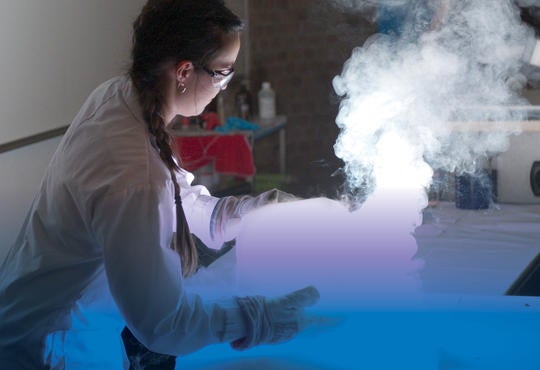During the first week I like to do an activity to loosen everyone up and reduce some of the anxiety students have about my Honors Chemistry class. Since I always feel crunched for time I choose an activity that will be fun but that will also cover some of the ground I need to address in the year. This year I tried a simple activity from Journal of Chemical Education1 that I usually use later in September. I moved it to the first week because it’s always a lot of fun and it would give the students fresh hands-on experience with the topics we will soon study: units, measurement and density. Plus, since I often give my students lab activities that require them to come up with their own procedure, I wanted them to get an early feel for the style of labs we’d do this year.
The challenge is to predict whether a bowling ball would sink or float when placed in a recycling bin full of water.
I explained the difference between guessing and predicting and that they should be able to support their prediction with calculations. It’s a good idea to have a few light balls that weigh 11 lbs or less as these will float. All regulation bowling balls have the same circumference and weigh between 8 to 16 pounds. Free bowling balls can be acquired by asking bowling alleys for their damaged or unclaimed balls. Be careful with 12 lb balls — their density is really close to that of water so measurements must be spot on.
Each pair of students was given their bowling ball, some string and a meter stick — but no directions. They had access to a heavy duty scale — borrowed from the Health Office — and a calculator. They were welcome to use the internet although I didn’t say what they’d need it for — formulas for the density and volume of a sphere, the density of water, conversion between pounds and grams. The remaining 30 minutes or so of class was theirs to work on the challenge. Additional 10-15 minutes were given the next day before we began testing predictions.
The concepts and skills in this activity are simple but are often taken for granted. It is perfect to start the year. Basically, the students needed to measure the mass and volume of the ball and use these numbers to calculate the density of the bowling ball and then compare the density of their ball to that of water. They had to pay close attention to units since the bathroom scale we used reports weight in pounds. Some groups chose to determine volume by using the string to measure the circumference while others measured the diameter by eye balling the edges of the ball on the meter stick. Either way, there were several reasonable units to use for the volume of the balls (mm3, cm3, in3) so students needed to be mindful of the units they chose to use and do conversions if necessary. It was insightful for me to note which students thought about whether the finger holes would make a difference and how these groups factored this into their calculations. For groups that were struggling and wondering about the finger holes, I discretely told them that the holes do not matter (and they don’t as they are negligible in this case). Some wondered how many decimal places they should include in their measurements which would later serve as a perfect lead-in question for an upcoming lesson on significant figures.
Before any group tests their prediction students have to explain their rationale to me. Since it was the first week, and I wanted the kids to have a positive experience and not immediately feel like they would not be successful in my class, I was more generous than I am later in the year in pointing out things they might wish to reconsider before testing. Rarely did a group calculate a reasonable density value on their first try. Overall, they made a wide variety of errors but the most common was a lack of agreement in units. Quite often students had density values for their bowling balls that were similar to those of gases rather than solids. This gave me an opportunity to remind them to check that an answer is realistic.2 Many had no idea what a reasonable density for a bowling ball was, so I pointed them to an online chart of densities to look for patterns in the values. It didn’t take them long to notice the huge difference in densities between gases and solids.
The most amusing part of the activity is the testing phase. Invariably, a student creates a drum roll to add to the suspense of the testing. The students whose calculations lead them to predict that their ball will float approach the water with considerable trepidation. While I try not to let any groups test their ball unless they will be successful, some mistakes do slip through. The classroom atmosphere by this time is one of fun and laughter and not of stress or pressure, so these “failures” don’t seem to hit the students too hard. This opportunity to review their work one-on-one starts fostering an atmosphere where it’s safe to make mistakes. I’m perceived as helpful, kind and understanding. When groups find that their predictions match their observations they are both relieved and joyous; high-fives abound, and they leave with a good feeling about this class and a better sense of who I am in the classroom.
1. Kathleen Holley and Diana Mason, “Bowling for Density”,
Journal of Chemical Education, 2004, page 1312A
2. Many students shifted the decimal 2 places when converting
cm3 to m3 resulting in the ball’s volume being around 50 m3! At this
point we discussed exactly how big 50 cubic meters really is.







